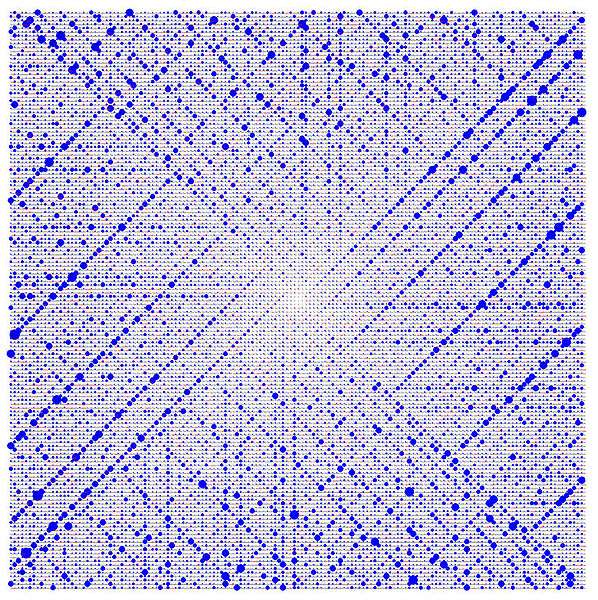It looks like you're using an Ad Blocker.
Please white-list or disable AboveTopSecret.com in your ad-blocking tool.
Thank you.
Some features of ATS will be disabled while you continue to use an ad-blocker.
11
share:
Sketching in your notebook when you’re bored in class or at a meeting isn’t always a bad thing – it might just help you discover one of math’s
greatest mysteries.
That’s exactly what happened when mathematician Stanislaw Ulam doodled on scratch paper during a scientific (boring!!) meeting, writing down rectangular numbers in a spiral with the number 1 at the center. Circling all the prime numbers – numbers that are only divisible by 1 and themselves – Ulam was surprised to note that they formed diagonal lines. Seemingly simple, yet still unexplained, the Ulam Spiral is sometimes seen as an example of inherent order in the universe.
How he did it?
Ulam constructed the spiral by writing down a regular rectangular grid of numbers, starting with 1 at the center, and spiraling out:

He then circled all of the prime numbers and he got the following picture:

To his surprise, the circled numbers tended to line up along diagonal lines.

The Ulam spiral to 150 iterations. Red dots represent prime numbers; blue dots represent composite numbers, with the size of the dot indicating the degree of compositeness.

This video explain how it works in a very educative way:
Will it be completely solved one day?
That’s exactly what happened when mathematician Stanislaw Ulam doodled on scratch paper during a scientific (boring!!) meeting, writing down rectangular numbers in a spiral with the number 1 at the center. Circling all the prime numbers – numbers that are only divisible by 1 and themselves – Ulam was surprised to note that they formed diagonal lines. Seemingly simple, yet still unexplained, the Ulam Spiral is sometimes seen as an example of inherent order in the universe.
How he did it?
Ulam constructed the spiral by writing down a regular rectangular grid of numbers, starting with 1 at the center, and spiraling out:

He then circled all of the prime numbers and he got the following picture:

To his surprise, the circled numbers tended to line up along diagonal lines.

The Ulam spiral to 150 iterations. Red dots represent prime numbers; blue dots represent composite numbers, with the size of the dot indicating the degree of compositeness.

This video explain how it works in a very educative way:
Will it be completely solved one day?
edit on 29-2-2012 by elevenaugust because: (no reason given)
Kind of looks like a galaxy.
Is this the blueprint for the stars? I've come to realize that math is of great importance in our universe...this just proves it.
s&f
Is this the blueprint for the stars? I've come to realize that math is of great importance in our universe...this just proves it.
s&f
really cool post! video was good as well! i love studying numbers.
reading a book on the golden ratio of phi right now.
thanx for the info,and the video link,gonna watch the whole series!
reading a book on the golden ratio of phi right now.
thanx for the info,and the video link,gonna watch the whole series!
reply to post by reficul
Here's a research article about the presence of Fibonacci and Lucas numbers in sacred geometries:
Part 1:
smphillips.8m.com...
Part 2:
smphillips.8m.com...
You may need to read some of the earlier research articles, as well as the material posted at the website generally, in order to understand it. The references will tell you which ones. This is original, rigorous work that has never been published before.
Here's a research article about the presence of Fibonacci and Lucas numbers in sacred geometries:
Part 1:
smphillips.8m.com...
Part 2:
smphillips.8m.com...
You may need to read some of the earlier research articles, as well as the material posted at the website generally, in order to understand it. The references will tell you which ones. This is original, rigorous work that has never been published before.
reply to post by elevenaugust
this is so damn cool, i dont even have a rational response!
Wish I was better at math and could offer something of substance to this thread, but instead I'll just pop in, express my pleasure, and watch you math buffs discuss this.
For anyone who find this extremely interesting, you may like this thread here
Cellular automata and rule 110
Its kind of like the opposite of the idea exposed here, mainly, apparent chaos resulting from a very deterministic rule.
this is so damn cool, i dont even have a rational response!
Wish I was better at math and could offer something of substance to this thread, but instead I'll just pop in, express my pleasure, and watch you math buffs discuss this.
For anyone who find this extremely interesting, you may like this thread here
Cellular automata and rule 110
Its kind of like the opposite of the idea exposed here, mainly, apparent chaos resulting from a very deterministic rule.
whenever a phenomena is encountered that seems complex it is taken almost for granted that the phenomenon must be the result of of some underlying mechanism that is itself complex. By my discovery that simple programs can produce great complexity makes it clear that this is not in fact correct. - Wolfram
There are patterns in the prime number sequence. In the Ulam spiral the numbers are charted along a square path so it's not unexpected that a
square-like grid emerges.
Here's an image that highlights the hexagonal pattern inherent in the prime sequence:
(primes = red)
Here's an image that highlights the hexagonal pattern inherent in the prime sequence:

(primes = red)
reply to post by circlemaker
Wow! Very interesting!!
Do you have another view of this hex pattern with more prime numbers? And what's specific property have the numbers in blue?
Wow! Very interesting!!
Do you have another view of this hex pattern with more prime numbers? And what's specific property have the numbers in blue?
edit on 29-2-2012
by elevenaugust because: (no reason given)
reply to post by circlemaker
And the blue are prime numbers x3 (except for 27 and 45) ?
And the blue are prime numbers x3 (except for 27 and 45) ?
edit on 29-2-2012 by Jessica6 because: (no reason given)
Originally posted by elevenaugust
reply to post by circlemaker
Wow! Very interesting!!
Do you have another view of this hex pattern with more prime numbers? And what's specific property have the numbers in blue?edit on 29-2-2012 by elevenaugust because: (no reason given)
The blues are divisible by 3, the grays are divisible by 2. That effectively removes 2/3 of the numbers so it's easier to narrow down the primes by focusing only on the rows which begin with 1 and 5. In the diagram the primes are red while blacks are divisible by primes.
I've charted the pattern on paper beyond 200 and it holds. I also created a _javascript algorithm based on this logic that goes well beyond 200, but it eventually runs out of memory and gets sluggish.
This thread needs more responses!
where are all the ATS math buffs?
where are all the ATS math buffs?
Originally posted by VonDoomen
This thread needs more responses!
where are all the ATS math buffs?
If you think the topic of this thread is fascinating, then I invite you to take a look at a thread that I authored on the Prime Numbers a while ago ... take a look and I think you'll be quite surprised at my research !
Adventures In PRIME NUMBER Land !!! ... (A Dummies Guide to Prime Numbers)
edit
on 29/2/12 by tauristercus because: (no reason given)
reply to post by tauristercus
Yes, great thread and a tone of research that I recommend to anyone!!
Incredible to see how the "24 pattern" is everywhere and how it helps solving some problems...
Yes, great thread and a tone of research that I recommend to anyone!!
Incredible to see how the "24 pattern" is everywhere and how it helps solving some problems...
new topics
-
Why Such An Uproar Over Non-US Citizens With H1-B Work Visas.
Social Issues and Civil Unrest: 1 hours ago -
Christmas Car Near Detroit…
Automotive Discussion: 3 hours ago -
Assetto Corsa EVO - a New Chapter in Simracing starts January 16th
Video Games: 6 hours ago -
The Phenomenon documentary by James Fox
Aliens and UFOs: 9 hours ago -
New UK Petition - Close the borders! Suspend ALL immigration for 5 years!
Regional Politics: 10 hours ago
top topics
-
Credit card debt
Relationships: 15 hours ago, 7 flags -
The Phenomenon documentary by James Fox
Aliens and UFOs: 9 hours ago, 7 flags -
President-elect Trump asks the Supreme Court to Let Tik-Tok Continue Operating in the U.S..
Mainstream News: 15 hours ago, 6 flags -
Christmas Car Near Detroit…
Automotive Discussion: 3 hours ago, 5 flags -
Why Such An Uproar Over Non-US Citizens With H1-B Work Visas.
Social Issues and Civil Unrest: 1 hours ago, 5 flags -
The Looking Glass - Episode 3: The Path of Least Resistance
Short Stories: 13 hours ago, 3 flags -
New UK Petition - Close the borders! Suspend ALL immigration for 5 years!
Regional Politics: 10 hours ago, 2 flags -
Assetto Corsa EVO - a New Chapter in Simracing starts January 16th
Video Games: 6 hours ago, 2 flags
active topics
-
Treasury Secretary Janet Yellen Says The USA Will Be in Debt Default in Jan 2025 - Unless...
Mainstream News • 34 • : xuenchen -
Plane Crash Today --Azerbaijanian E190 passenger jet
Mainstream News • 64 • : tomeville -
Why Such An Uproar Over Non-US Citizens With H1-B Work Visas.
Social Issues and Civil Unrest • 12 • : cherokeetroy -
Liberal Madness and the Constitution of the United States
US Political Madness • 19 • : charlest2 -
Christmas Car Near Detroit…
Automotive Discussion • 3 • : BeyondKnowledge3 -
1 Billion dollars
General Entertainment • 15 • : mblahnikluver -
President-elect Trump asks the Supreme Court to Let Tik-Tok Continue Operating in the U.S..
Mainstream News • 24 • : WeMustCare -
Awesome Dip Recipe
Food and Cooking • 7 • : mblahnikluver -
Christmas Dinner ??
Food and Cooking • 19 • : mblahnikluver -
Trump's idea to make Canada the 51st US state: 'Potential is massive'
Mainstream News • 103 • : NorthOS
11
